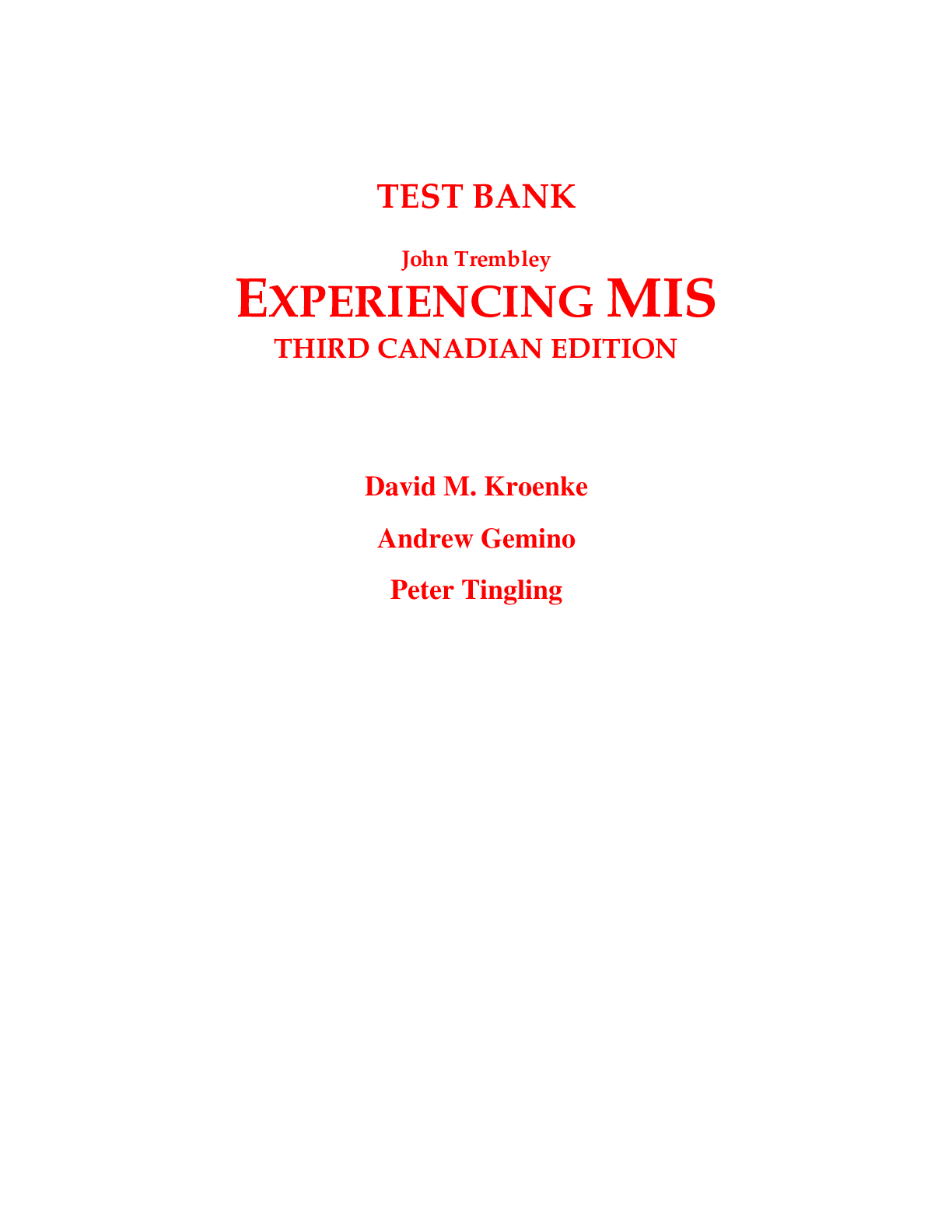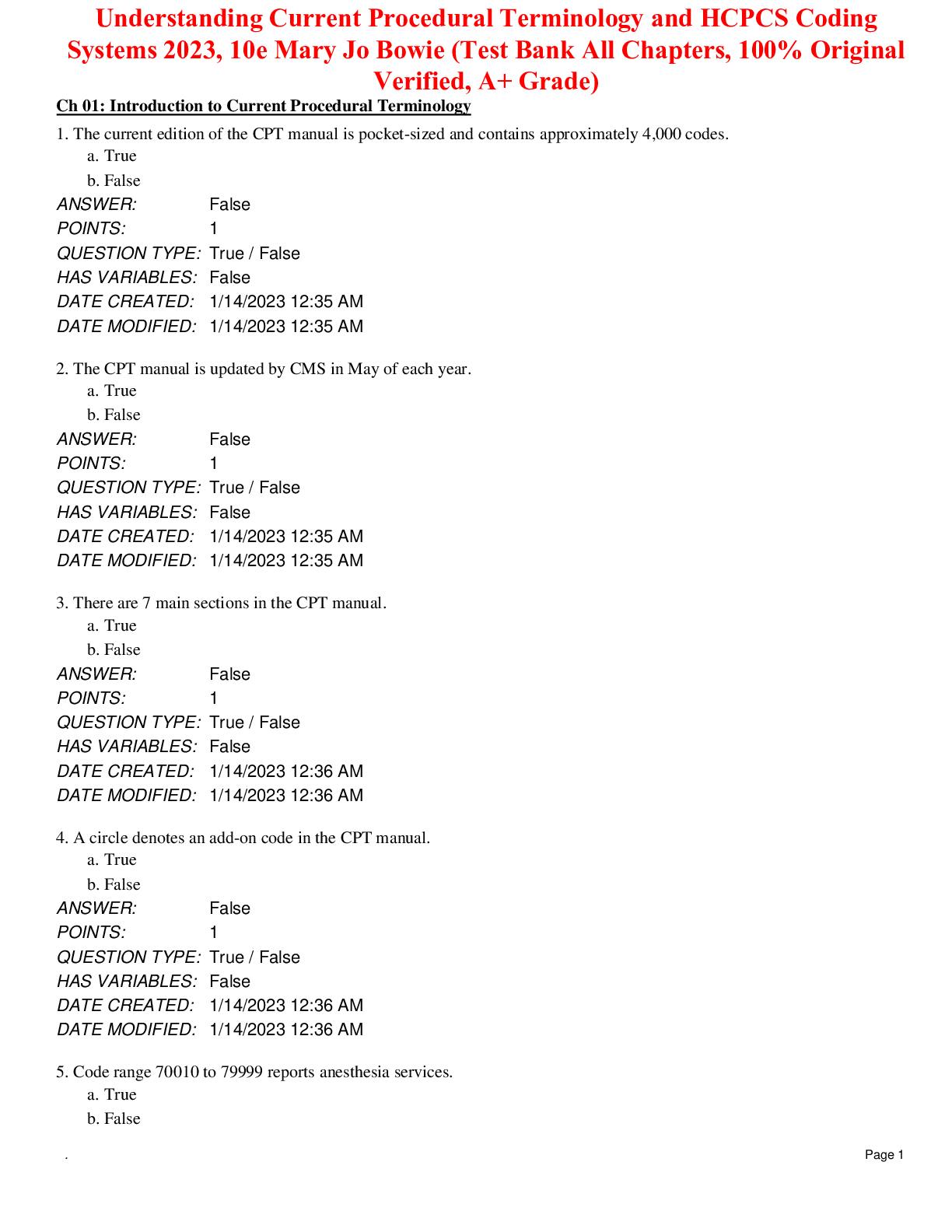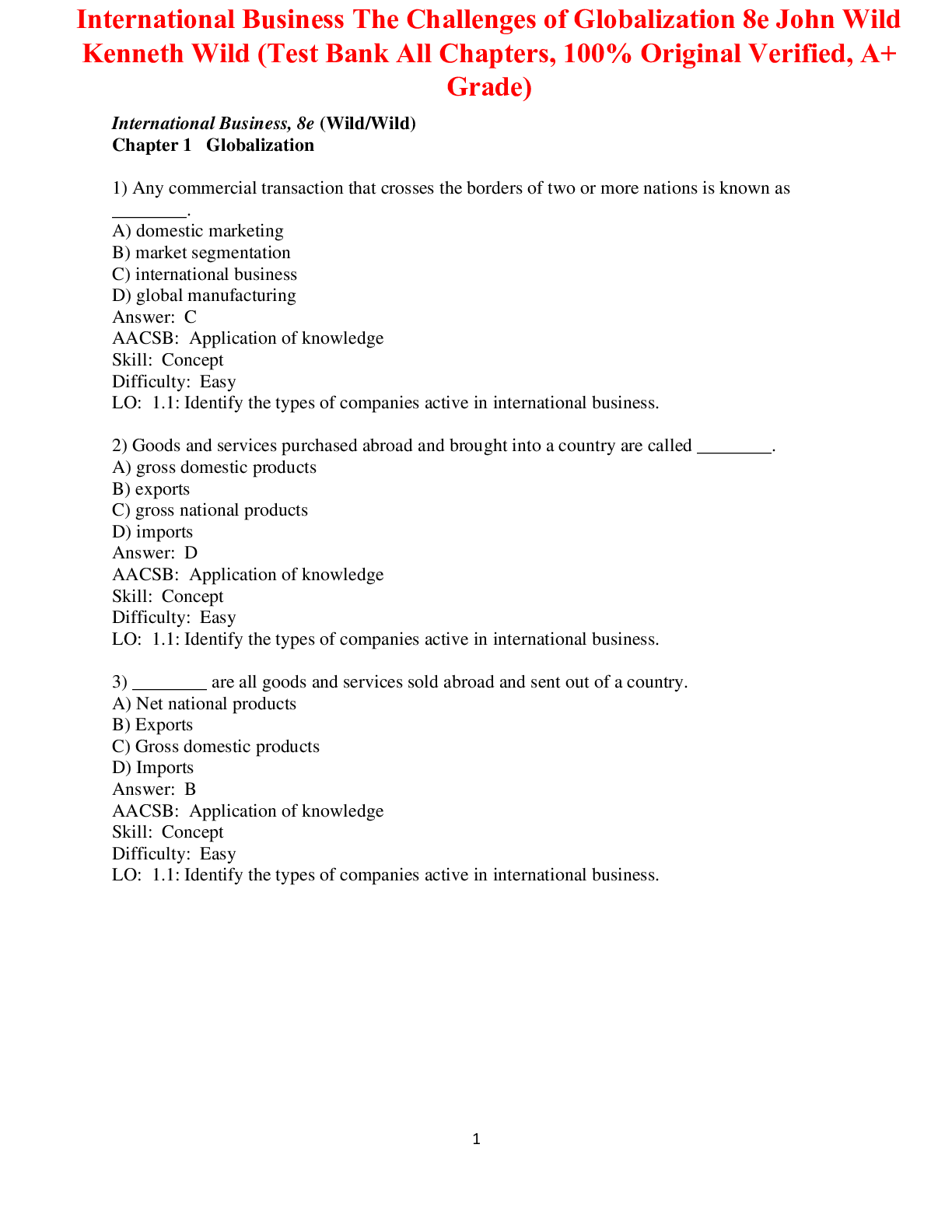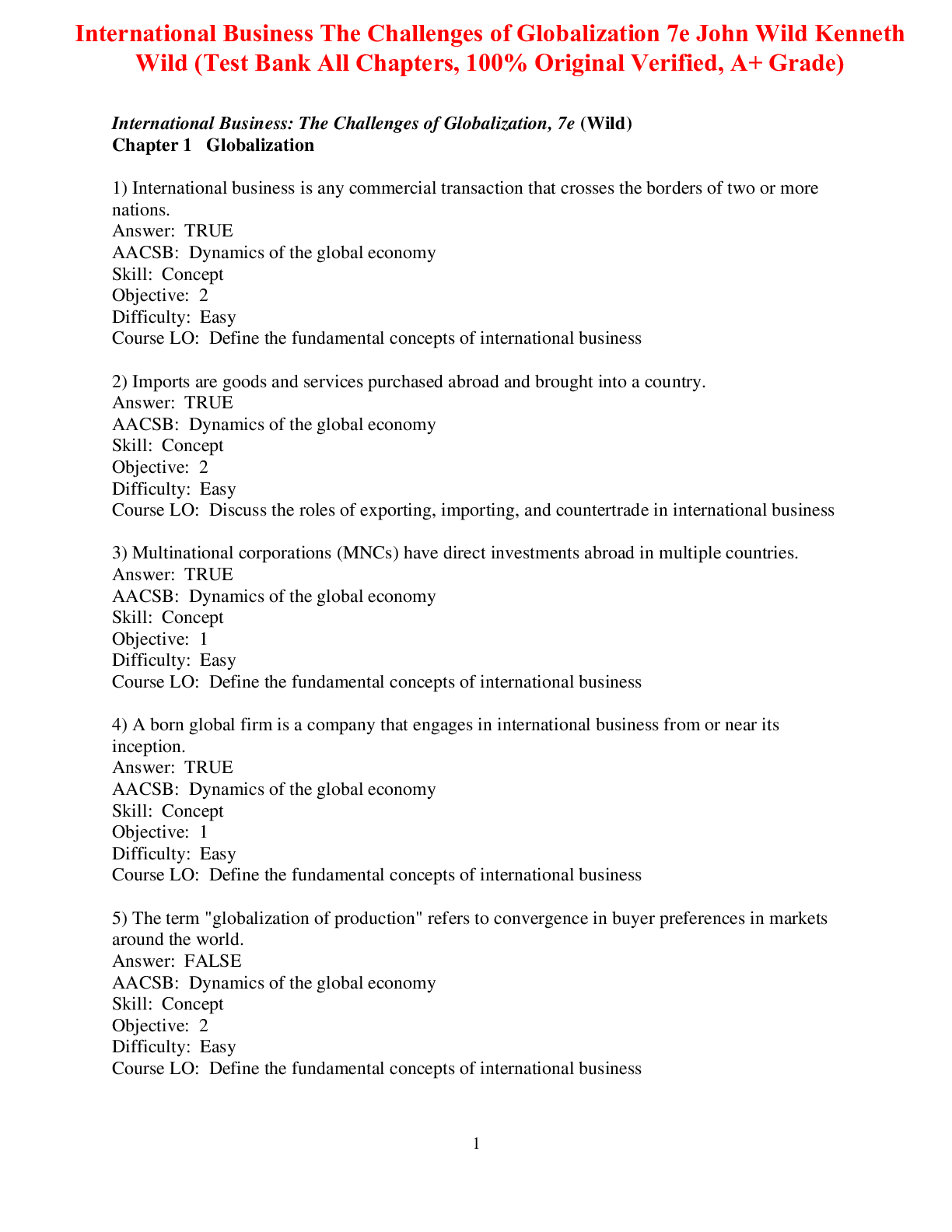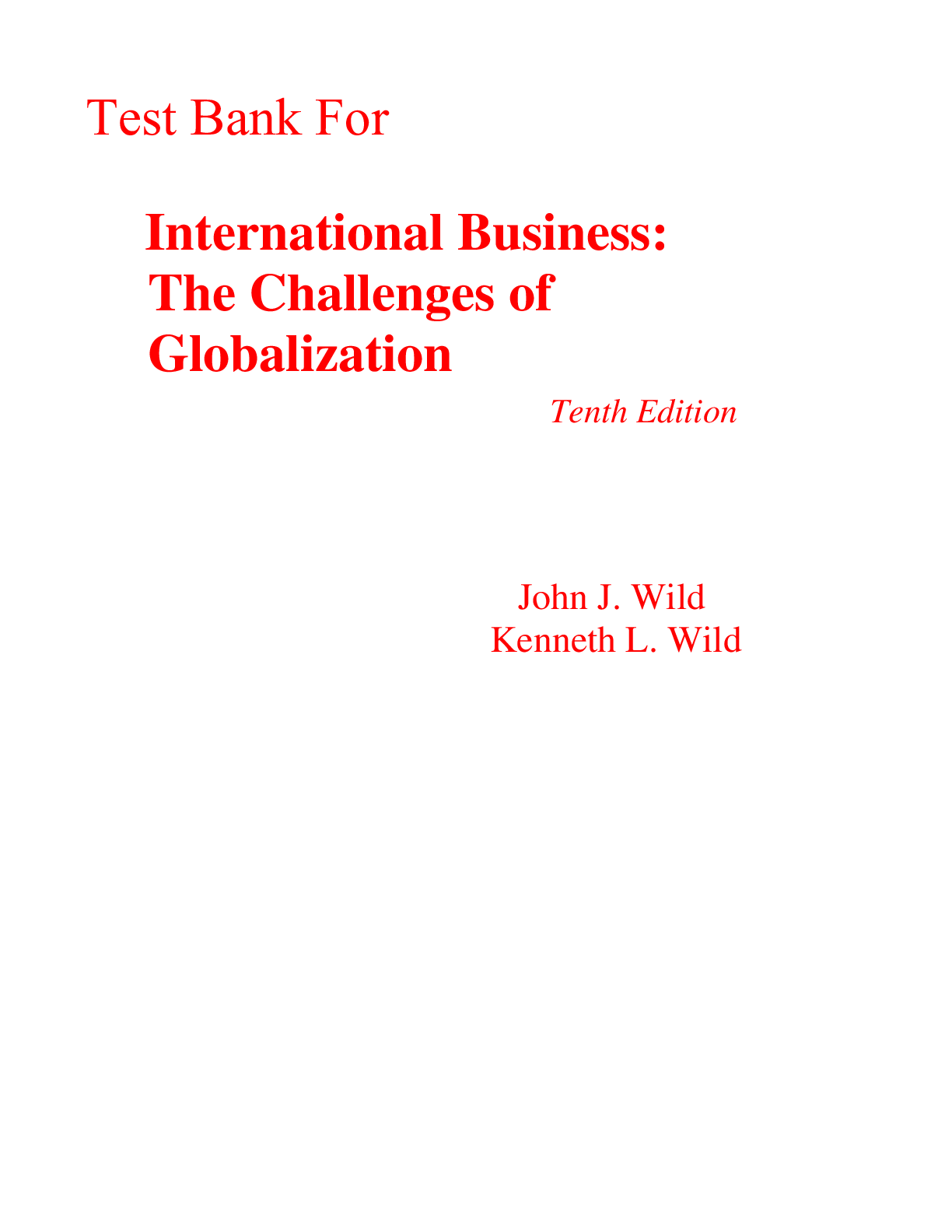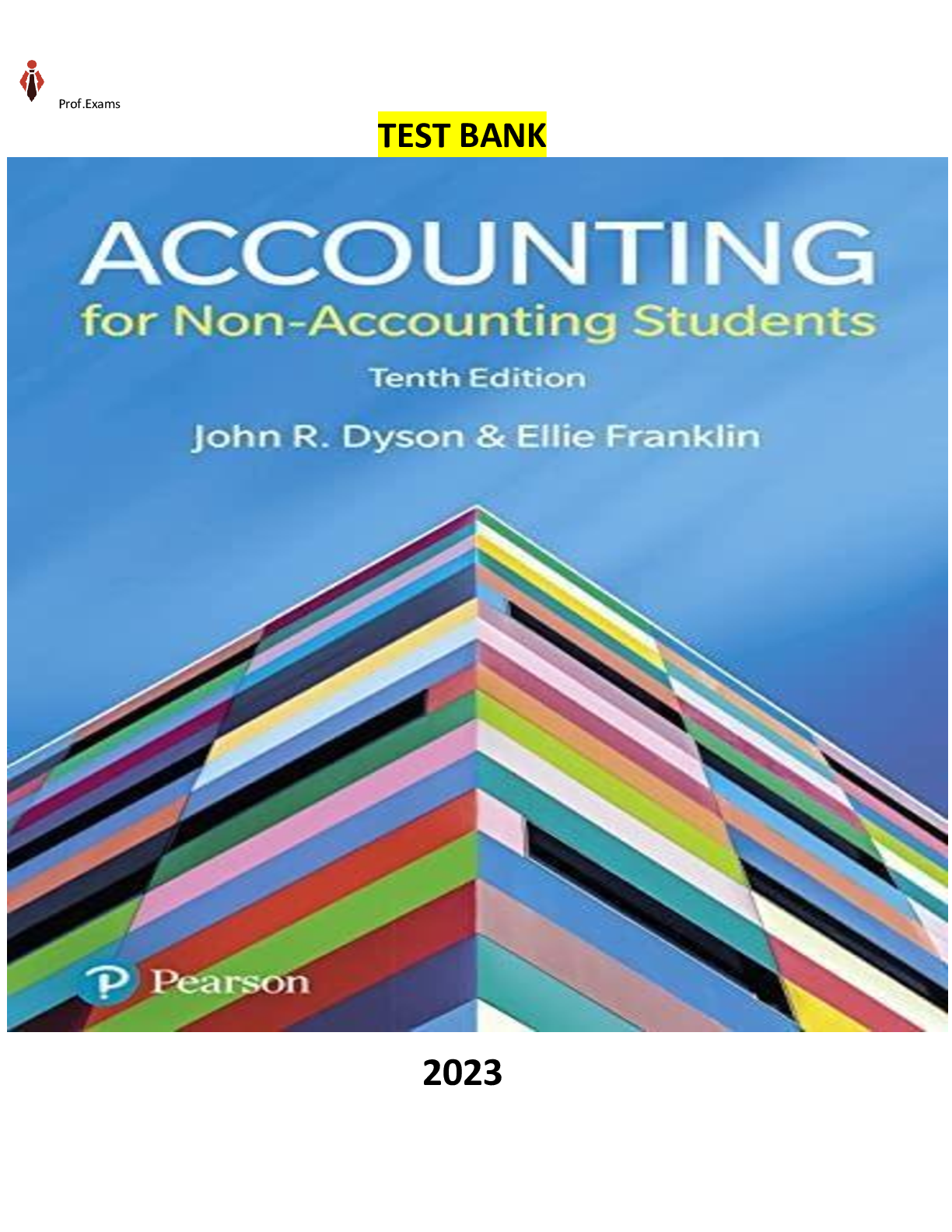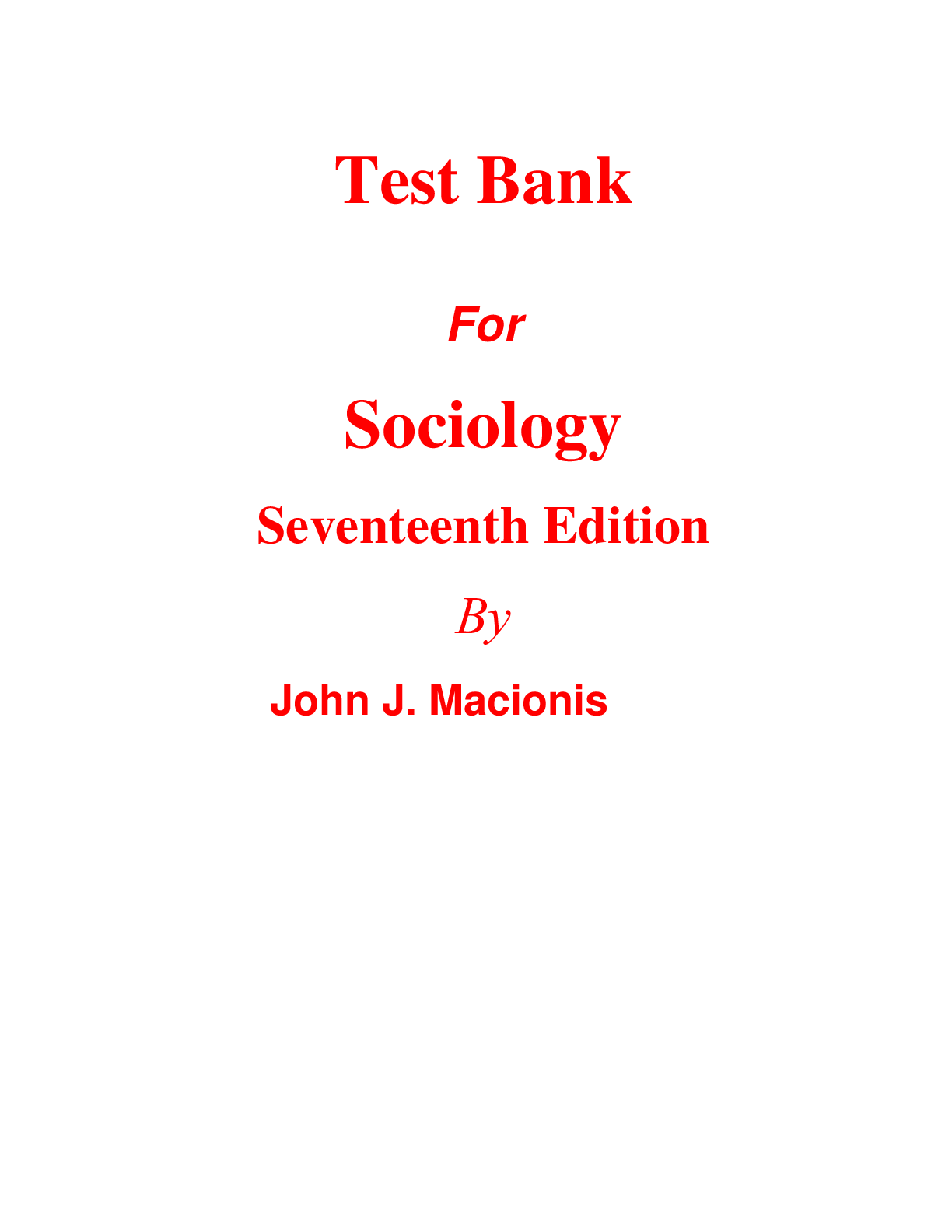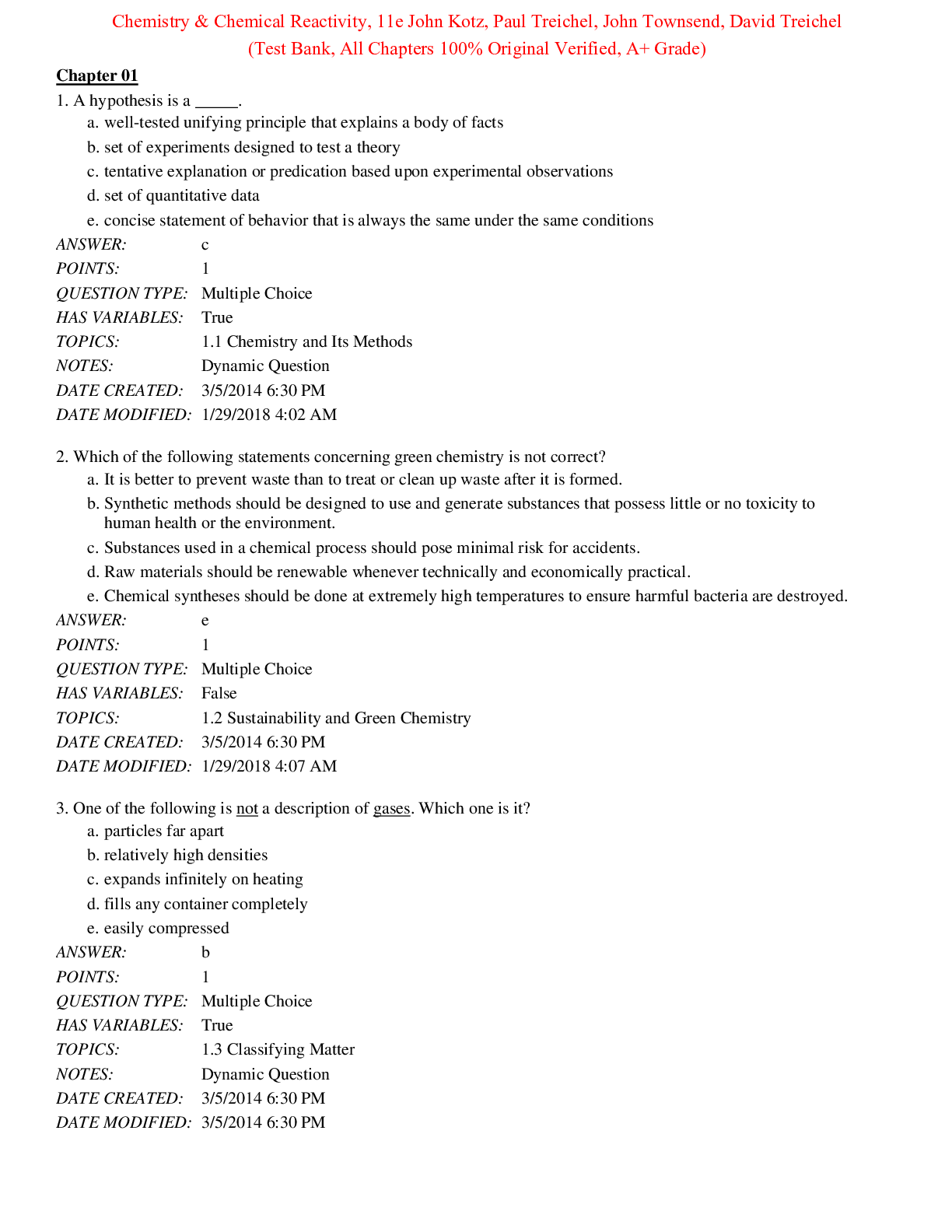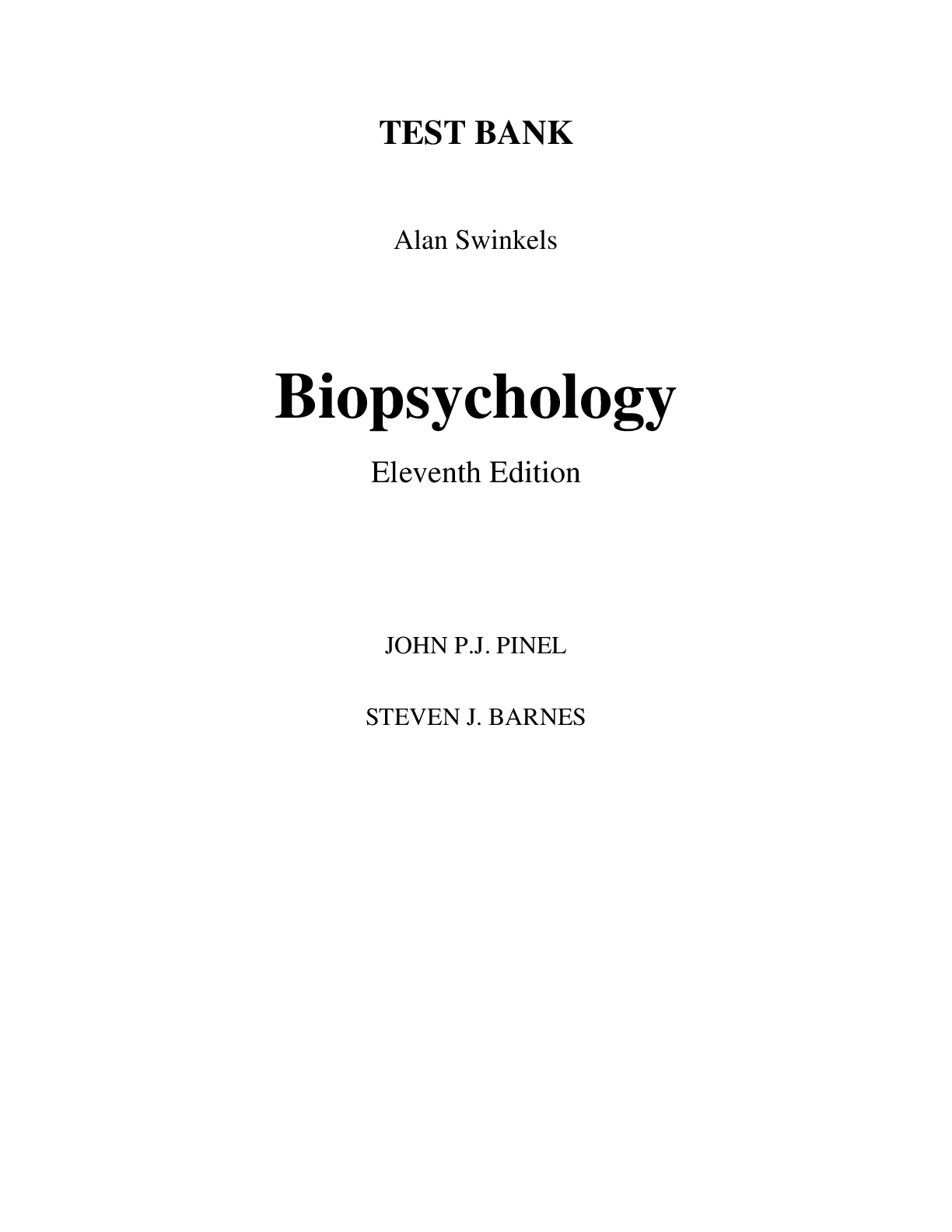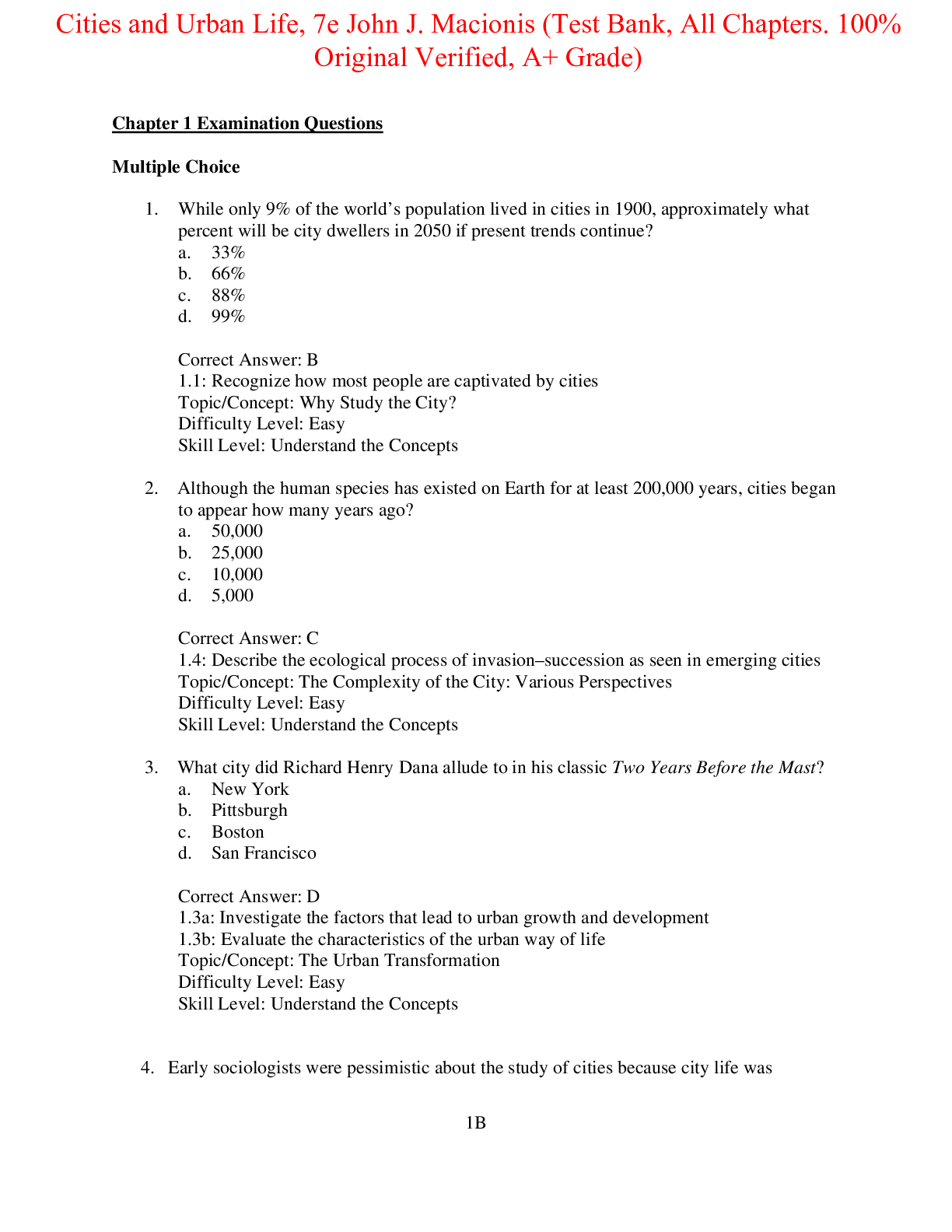Engineering > TEST BANK > Digital Signal Processing Principles, Algorithms and Applications, 5th edition By John G. Proakis, D (All)
Digital Signal Processing Principles, Algorithms and Applications, 5th edition By John G. Proakis, Dimitris G Manolakis (Test Bank )
Document Content and Description Below
Table of Contents Introduction 1.1 Signals, Systems, and Signal Processing 1.1.1 Basic Elements of a Digital Signal Processing System 1.1.2 Advantages of Digital over Analog Signal Processing 1.2... Classification of Signals 1.2.1 Multichannel and Multidimensional Signals 1.2.2 Continuous-Time Versus Discrete-Time Signals 1.2.3 Continuous-Valued Versus Discrete-Valued Signals 1.2.4 Deterministic Versus Random Signals 1.3 Summary Problems Discrete-Time Signals and Systems 2.1 Discrete-Time Signals 2.1.1 Some Elementary Discrete-Time Signals 2.1.2 Classification of Discrete-Time Signals 2.1.3 Simple Manipulations of Discrete-Time Signals 2.2 Discrete-Time Systems 2.2.1 Input-Output Description of Systems 2.2.2 Block Diagram Representation of Discrete-Time Systems 2.2.3 Classification of Discrete-Time Systems 2.2.4 Interconnection of Discrete-Time Systems 2.3 Analysis of Discrete-Time Linear Time-Invariant Systems 2.3.1 Techniques for the Analysis of Linear Systems 2.3.2 Resolution of a Discrete-Time Signal into Impulses 2.3.3 Response of LTI Systems to Arbitrary Inputs: The Convolution Sum 2.3.4 Properties of Convolution and the Interconnection of LTI Systems 2.3.5 Causal Linear Time-Invariant Systems 2.3.6 Stability of Linear Time-Invariant Systems 2.3.7 Systems with Finite-Duration and Infinite-Duration Impulse Response 2.4 Discrete-Time Systems Described by Difference Equations 2.4.1 Recursive and Nonrecursive Discrete-Time Systems 2.4.2 Linear Time-Invariant Systems Characterized by Constant-Coefficient Difference Equations 2.4.3 Application of LTI Systems for Signal Smoothing 2.5 Implementation of Discrete-Time Systems 2.5.1 Structures for the Realization of Linear Time-Invariant Systems 2.5.2 Recursive and Nonrecursive Realizations of FIR Systems 2.6 Correlation of Discrete-Time Signals 2.6.1 Crosscorrelation and Autocorrelation Sequences 2.6.2 Properties of the Autocorrelation and Crosscorrelation Sequences 2.6.3 Correlation of Periodic Sequences 2.6.4 Input-Output Correlation Sequences 2.7 Summary Problems Computer Problems The z-Transform and Its Application to the Analysis of LTI Systems 3.1 The z-Transform 3.1.1 The Direct z-Transform 3.1.2 The Inverse z-Transform 3.2 Properties of the z-Transform 3.3 Rational z-Transforms 3.3.1 Poles and Zeros 3.3.2 Pole Location and Time-Domain Behavior for Causal Signals 3.3.3 The System Function of a Linear Time-Invariant System 3.4 Inversion of the z-Transform 3.4.1 The Inverse z-Transform by Contour Integration 3.4.2 The Inverse z-Transform by Power Series Expansion 3.4.3 The Inverse z-Transform by Partial-Fraction Expansion 3.4.4 Decomposition of Rational z-Transforms 3.5 Analysis of Linear Time-Invariant Systems in the z-Domain 3.5.1 Response of Systems with Rational System Functions 3.5.2 Transient and Steady-State Responses 3.5.3 Causality and Stability 3.5.4 Pole—Zero Cancellations 3.5.5 Multiple-Order Poles and Stability 3.5.6 Stability of Second-Order Systems 3.6 The One-sided z-Transform 3.6.1 Definition and Properties 3.6.2 Solution of Difference Equations 3.6.3 Response of Pole—Zero Systems with Nonzero Initial Conditions 3.7 Summary Problems Computer Problems Frequency Analysis of Signals 4.1 The Concept of Frequency in Continuous-Time and Discrete-Time Signals 4.1.1 Continuous-Time Sinusoidal Signals 4.1.2 Discrete-Time Sinusoidal Signals 4.1.3 Harmonically Related Complex Exponentials 4.1.4 Sampling of Analog Signals 4.1.5 The Sampling Theorem 4.2 Frequency Analysis of Continuous-Time Signals 4.2.1 The Fourier Series for Continuous-Time Periodic Signals 4.2.2 Power Density Spectrum of Periodic Signals 4.2.3 The Fourier Transform for Continuous-Time Aperiodic Signals 4.2.4 Energy Density Spectrum of Aperiodic Signals 4.3 Frequency Analysis of Discrete-Time Signals 4.3.1 The Fourier Series for Discrete-Time Periodic Signals 4.3.2 Power Density Spectrum of Periodic Signals 4.3.3 The Fourier Transform of Discrete-Time Aperiodic Signals 4.3.4 Convergence of the Fourier Transform 4.3.5 Energy Density Spectrum of Aperiodic Signals 4.3.6 Relationship of the Fourier Transform to the z-Transform 4.3.7 The Cepstrum 4.3.8 The Fourier Transform of Signals with Poles on the Unit Circle 4.3.9 Frequency-Domain Classification of Signals: The Concept of Bandwidth 4.3.10 The Frequency Ranges of Some Natural Signals 4.4 Frequency-Domain and Time-Domain Signal Properties 4.5 Properties of the Fourier Transform for Discrete-Time Signals 4.5.1 Symmetry Properties of the Fourier Transform 4.5.2 Fourier Transform Theorems and Properties 4.6 Summary Problems Computer Problems Frequency-Domain Analysis of LTI Systems 5.1 Frequency-Domain Characteristics of Linear Time-Invariant Systems 5.1.1 Response to Complex Exponential and Sinusoidal Signals: The Frequency Response Function 5.1.2 Steady-State and Transient Response to Sinusoidal Input Signals 5.1.3 Steady-State Response to Periodic Input Signals 5.1.4 Steady-State Response to Aperiodic Input Signals 5.2 Frequency Response of LTI Systems 5.2.1 Frequency Response of a System with a Rational System Function 5.2.2 Computation of the Frequency Response Function 5.3 Correlation Functions and Spectra at the Output of LTI Systems 5.4 Linear Time-Invariant Systems as Frequency-Selective Filters 5.4.1 Ideal Filter Characteristics 5.4.2 Lowpass, Highpass, and Bandpass Filters 5.4.3 Digital Resonators 5.4.4 Notch Filters 5.4.5 Comb Filters 5.4.6 Reverberation Filters 5.4.7 All-Pass Filters 5.4.8 Digital Sinusoidal Oscillators 5.5 Inverse Systems and Deconvolution 5.5.1 Invertibility of Linear Time-Invariant Systems 5.5.2 Minimum-Phase, Maximum-Phase, and Mixed-Phase Systems 5.5.3 System Identification and Deconvolution 5.5.4 Homomorphic Deconvolution 5.6 Summary Problems Computer Problems Sampling and Reconstruction of Signals 6.1 Ideal Sampling and Reconstruction of Continuous-Time Signals 6.2 Discrete-Time Processing of Continuous-Time Signals 6.3 Sampling and Reconstruction of Continuous-Time Bandpass Signals 6.3.1 Uniform or First-Order Sampling 6.3.2 Interleaved or Nonuniform Second-Order Sampling 6.3.3 Bandpass Signal Representations 6.3.4 Sampling Using Bandpass Signal Representations 6.4 Sampling of Discrete-Time Signals 6.4.1 Sampling and Interpolation of Discrete-Time Signals 6.4.2 Representation and Sampling of Bandpass Discrete-Time Signals 6.5 Analog-to-Digital and Digital-to-Analog Converters 6.5.1 Analog-to-Digital Converters 6.5.2 Quantization and Coding 6.5.3 Analysis of Quantization Errors 6.5.4 Digital-to-Analog Converters 6.6 Oversampling A/D and D/A Converters 6.6.1 Oversampling A/D Converters 6.6.2 Oversampling D/A Converters 6.7 Summary Problems Computer Problems The Discrete Fourier Transform: Its Properties and Applications 7.1 Frequency-Domain Sampling: The Discrete Fourier Transform 7.1.1 Frequency-Domain Sampling and Reconstruction of Discrete-Time Signals 7.1.2 The Discrete Fourier Transform (DFT) 7.1.3 The DFT as a Linear Transformation 7.1.4 Relationship of the DFT to Other Transforms 7.2 Properties of the DFT 7.2.1 Periodicity, Linearity, and Symmetry Properties 7.2.2 Multiplication of Two DFTs and Circular Convolution 7.2.3 Additional DFT Properties 7.3 Linear Filtering Methods Based on the DFT 7.3.1 Use of the DFT in Linear Filtering 7.3.2 Filtering of Long Data Sequences 7.4 Frequency Analysis of Signals Using the DFT 7.5 The Short-Time Fourier Transform 7.6 The Discrete Cosine Transform 7.6.1 Forward DCT 7.6.2 Inverse DCT 7.6.3 DCT as an Orthogonal Transform 7.7 Summary Problems Computer Problems Efficient Computation of the DFT: Fast Fourier Transform Algorithms 8.1 Efficient Computation of the DFT: FFT Algorithms 8.1.1 Direct Computation of the DFT 8.1.2 Divide-and-Conquer Approach to Computation of the DFT 8.1.3 Radix-2 FFT Algorithms 8.1.4 Radix-4 FFT Algorithms 8.1.5 Split-Radix FFT Algorithms 8.1.6 Implementation of FFT Algorithms 8.1.7 Sparse FFT Algorithm 8.2 Applications of FFT Algorithms 8.2.1 Efficient Computation of the DFT of Two Real Sequences 8.2.2 Efficient Computation of the DFT of a 2N-Point Real Sequence 8.2.3 Use of the FFT Algorithm in Linear Filtering and Correlation 8.3 A Linear Filtering Approach to Computation of the DFT 8.3.1 The Goertzel Algorithm 8.3.2 The Chirp-z Transform Algorithm 8.4 Quantization Effects in the Computation of the DFT 8.4.1 Quantization Errors in the Direct Computation of the DFT 8.4.2 Quantization Errors in FFT Algorithms 8.5 Summary Problems Computer Problems Implementation of Discrete-Time Systems 9.1 Structures for the Realization of Discrete-Time Systems 9.2 Structures for FIR Systems 9.2.1 Direct-Form Structure 9.2.2 Cascade-Form Structures 9.2.3 Frequency-Sampling Structures 9.2.4 Lattice Structure 9.3 Structures for IIR Systems 9.3.1 Direct-Form Structures 9.3.2 Signal Flow Graphs and Transposed Structures 9.3.3 Cascade-Form Structures 9.3.4 Parallel-Form Structures 9.3.5 Lattice and Lattice-Ladder Structures for IIR Systems 9.4 Representation of Numbers 9.4.1 Fixed-Point Representation of Numbers 9.4.2 Binary Floating-Point Representation of Numbers 9.4.3 Errors Resulting from Rounding and Truncation 9.5 Quantization of Filter Coefficients 9.5.1 Analysis of Sensitivity to Quantization of Filter Coefficients 9.5.2 Quantization of Coefficients in FIR Filters 9.6 Round-Off Effects in Digital Filters 9.6.1 Limit-Cycle Oscillations in Recursive Systems 9.6.2 Scaling to Prevent Overflow 9.6.3 Statistical Characterization of Quantization Effects in Fixed-Point Realizations of Digital Filters 9.7 Summary Problems Computer Problems Design of Digital Filters 10.1 General Considerations 10.1.1 Causality and Its Implications 10.1.2 Characteristics of Practical Frequency-Selective Filters 10.2 Design of FIR Filters 10.2.1 Symmetric and Antisymmetric FIR Filters 10.2.2 Design of Linear-Phase FIR Filters Using Windows 10.2.3 Design of Linear-Phase FIR Filters by the Frequency-Sampling Method 10.2.4 Design of Optimum Equiripple Linear-Phase FIR Filters 10.2.5 Design of FIR Differentiators 10.2.6 Design of Hilbert Transformers 10.2.7 Comparison of Design Methods for Linear-Phase FIR Filters 10.3 Design of IIR Filters From Analog Filters 10.3.1 IIR Filter Design by Approximation of Derivatives 10.3.2 IIR Filter Design by Impulse Invariance 10.3.3 IIR Filter Design by the Bilinear Transformation 10.3.4 Characteristics of Commonly Used Analog Filters 10.3.5 Some Examples of Digital Filter Designs Based on the Bilinear Transformation 10.4 Frequency Transformations 10.4.1 Frequency Transformations in the Analog Domain 10.4.2 Frequency Transformations in the Digital Domain 10.5 Summary Problems Computer Problems Multirate Digital Signal Processing 11.1 Introduction 11.2 Decimation by a Factor D 11.3 Interpolation by a Factor I 11.4 Sampling Rate Conversion by a Rational Factor I /D 11.5 Implementation of Sampling Rate Conversion 11.5.1 Polyphase Filter Structures 11.5.2 Interchange of Filters and Downsamplers/Upsamplers 11.5.3 Sampling Rate Conversion with Cascaded Integrator Comb Filters 11.5.4 Polyphase Structures for Decimation and Interpolation Filters 11.5.5 Structures for Rational Sampling Rate Conversion 11.6 Multistage Implementation of Sampling Rate Conversion 11.7 Sampling Rate Conversion of Bandpass Signals 11.8 Sampling Rate Conversion by an Arbitrary Factor 11.8.1 Arbitrary Resampling with Polyphase Interpolators 11.8.2 Arbitrary Resampling with Farrow Filter Structures 11.9 Applications of Multirate Signal Processing 11.9.1 Design of Phase Shifters 11.9.2 Interfacing of Digital Systems with Different Sampling Rates 11.9.3 Implementation of Narrowband Lowpass Filters 11.9.4 Subband Coding of Speech Signals 11.10 Summary Problems Computer Problems Multirate Digital Filter Banks and Wavelets 12.1 Multirate Digital Filter Banks 12.1.1 DFT Filter Banks 12.1.2 Polyphase Structure of the Uniform DFT Filter Bank 12.1.3 An Alternative Structure of the Uniform DFT Filter Bank 12.2 Two-Channel Quadrature Mirror Filter Bank 12.2.1 Elimination of Aliasing 12.2.2 Polyphase Structure of the QMF Bank 12.2.3 Condition for Perfect Reconstruction 12.2.4 Linear Phase FIR QMF Bank 12.2.5 IIR QMF Bank 12.2.6 Perfect Reconstruction in Two-Channel FIR QMF Bank 12.2.7 Two-Channel Paraunitary QMF Bank 12.2.8 Orthogonal and Biorthogonal Two-channel FIR Filter Banks 12.2.9 Two-Channel QMF Banks in Subband Coding 12.3 M-Channel Filter Banks 12.3.1 Polyphase Structure for the M-Channel Filter Bank 12.3.2 M-Channel Paraunitary Filter Banks 12.4 Wavelets and Wavelet Transforms 12.4.1 Ideal Bandpass Wavelet Decomposition 12.4.2 Signal Spaces and Wavelets 12.4.3 Multiresolution Analysis and Wavelets 12.4.4 The Discrete Wavelet Transform 12.5 From Wavelets to Filter Banks 12.5.1 Dilation Equations 12.5.2 Orthogonality Conditions 12.5.3 Implications of Orthogonality and Dilation Equations 12.6 From Filter Banks to Wavelets 12.7 Regular Filters and Wavelets 12.8 Summary Problems Computer Problems Linear Prediction and Optimum Linear Filters 13.1 Random Signals, Correlation Functions, and Power Spectra 13.1.1 Random Processes 13.1.2 Stationary Random Processes 13.1.3 Statistical (Ensemble) Averages 13.1.4 Statistical Averages for Joint Random Processes 13.1.5 Power Density Spectrum 13.1.6 Discrete-Time Random Signals 13.1.7 Time Averages for a Discrete-Time Random Process 13.1.8 Mean-Ergodic Process 13.1.9 Correlation-Ergodic Processes 13.1.10 Correlation Functions and Power Spectra for Random Input Signals to LTI Systems 13.2 Innovations Representation of a Stationary Random Process 13.2.1 Rational Power Spectra 13.2.2 Relationships Between the Filter Parameters and the Autocorrelation Sequence 13.3 Forward and Backward Linear Prediction 13.3.1 Forward Linear Prediction 13.3.2 Backward Linear Prediction 13.3.3 The Optimum Reflection Coefficients for the Lattice Forward and Backward Predictors 13.3.4 Relationship of an AR Process to Linear Prediction 13.4 Solution of the Normal Equations 13.4.1 The Levinson—Durbin Algorithm 13.5 Properties of the Linear Prediction-Error Filters 13.6 AR Lattice and ARMA Lattice-Ladder Filters 13.6.1 AR Lattice Structure 13.6.2 ARMA Processes and Lattice-Ladder Filters 13.7 Wiener Filters for Filtering and Prediction 13.7.1 FIR Wiener Filter 13.7.2 Orthogonality Principle in Linear Mean-Square Estimation 13.7.3 IIR Wiener Filter 13.7.4 Noncausal Wiener Filter 13.8 Summary Problems Computer Problems Adaptive Filters 14.1 Applications of Adaptive Filters 14.1.1 System Identification or System Modeling 14.1.2 Adaptive Channel Equalization 14.1.3 Suppression of Narrowband Interference in a Wideband Signal 14.1.4 Adaptive Line Enhancer 14.1.5 Adaptive Noise Cancelling 14.1.6 Adaptive Arrays 14.2 Adaptive Direct-Form FIR Filters - The LMS Algorithm 14.2.1 Minimum Mean-Square-Error Criterion 14.2.2 The LMS Algorithm 14.2.3 Related Stochastic Gradient Algorithms 14.2.4 Properties of the LMS Algorithm 14.3 Adaptive Direct-Form Filters - RLS Algorithms 14.3.1 RLS Algorithm 14.3.2 The LDU Factorization and Square-Root Algorithms 14.3.3 Fast RLS Algorithms 14.3.4 Properties of the Direct-Form RLS Algorithms 14.4 Adaptive Lattice-Ladder Filters 14.4.1 Recursive Least-Squares Lattice-Ladder Algorithms 14.4.2 Other Lattice Algorithms 14.4.3 Properties of Lattice-Ladder Algorithms 14.5 Stability and Robustness of Adaptive Filter Algorithms 14.6 Summary Problems Computer Problems Power Spectrum Estimation 15.1 Estimation of Spectra from Finite-Duration Observations of Signals 15.1.1 Computation of the Energy Density Spectrum 15.1.2 Estimation of the Autocorrelation and Power Spectrum of Random Signals: The Periodogram 15.1.3 The Use of the DFT in Power Spectrum Estimation 15.2 Nonparametric Methods for Power Spectrum Estimation 15.2.1 The Bartlett Method: Averaging Periodograms 15.2.2 The Welch Method: Averaging Modified Periodograms 15.2.3 The Blackman and Tukey Method: Smoothing the Periodogram 15.2.4 Performance Characteristics of Nonparametric Power Spectrum Estimators 15.2.5 Computational Requirements of Nonparametric Power Spectrum Estimates 15.3 Parametric Methods for Power Spectrum Estimation 15.3.1 Relationships Between the Autocorrelation and the Model Parameters 15.3.2 The Yule—Walker Method for the AR Model Parameters 15.3.3 The Burg Method for the AR Model Parameters 15.3.4 Unconstrained Least-Squares Method for the AR Model Parameters 15.3.5 Sequential Estimation Methods for the AR Model Parameters 15.3.6 Selection of AR Model Order 15.3.7 MA Model for Power Spectrum Estimation 15.3.8 ARMA Model for Power Spectrum Estimation 15.3.9 Some Experimental Results 15.4 ARMA Model Parameter Estimation 15.5 Filter Bank Methods 15.5.1 Filter Bank Realization of the Periodogram 15.5.2 Minimum Variance Spectral Estimates 15.6 Eigenanalysis Algorithms for Spectrum Estimation 15.6.1 Pisarenko Harmonic Decomposition Method 15.6.2 Eigen-decomposition of the Autocorrelation Matrix for Sinusoids in White Noise 15.6.3 MUSIC Algorithm 15.6.4 ESPRIT Algorithm 15.6.5 Order Selection Criteria 15.6.6 Experimental Results 15.7 Summary Problems Computer Problems Random Number Generators Tables of Transition Coefficients for the Design of Linear-Phase FIR Filters References and Bibliography Answers to Selected Problems Index [Show More]
Last updated: 1 year ago
Preview 1 out of 335 pages
Instant download

Instant download
Reviews( 0 )
Document information
Connected school, study & course
About the document
Uploaded On
Nov 16, 2022
Number of pages
335
Written in
Additional information
This document has been written for:
Uploaded
Nov 16, 2022
Downloads
0
Views
34

.png)

.png)


.png)
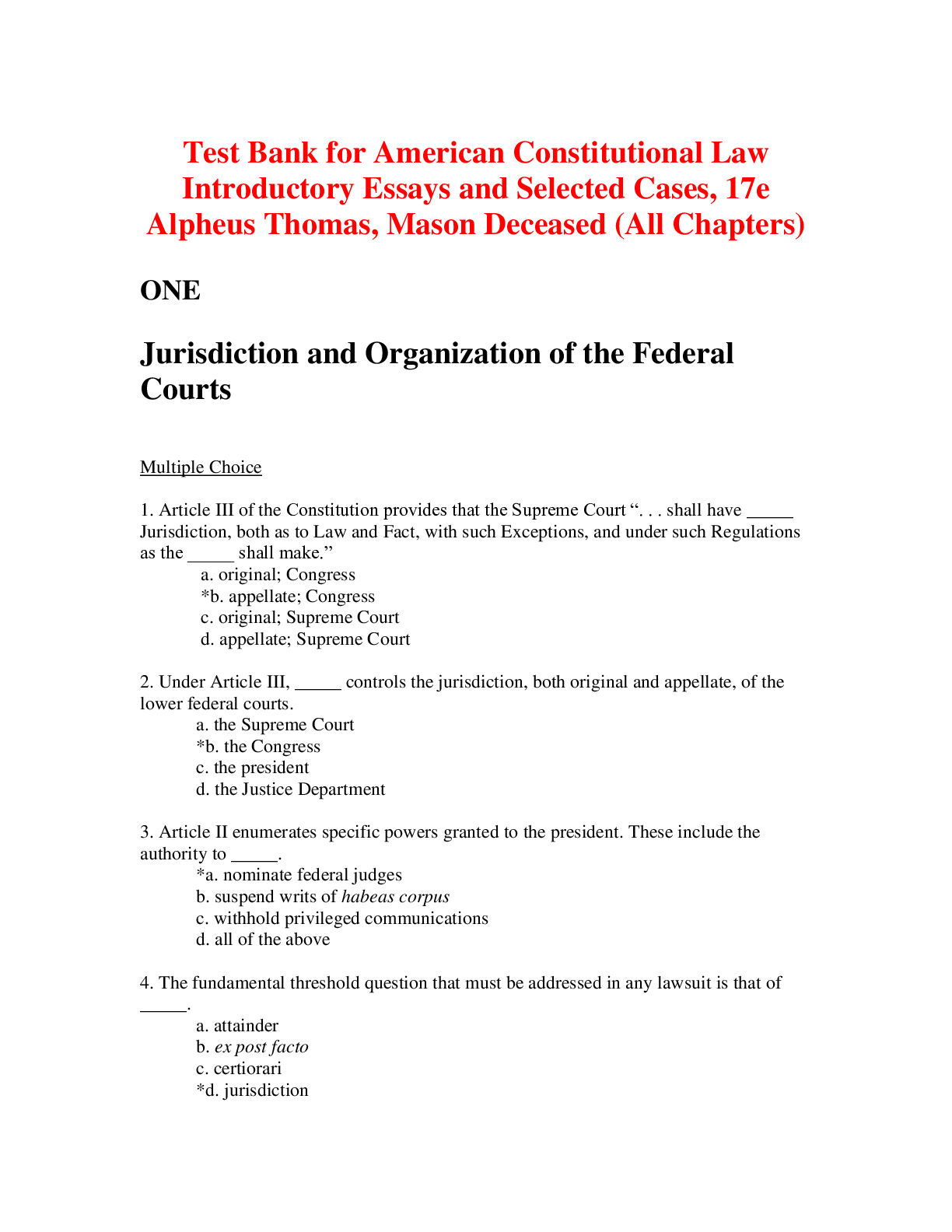


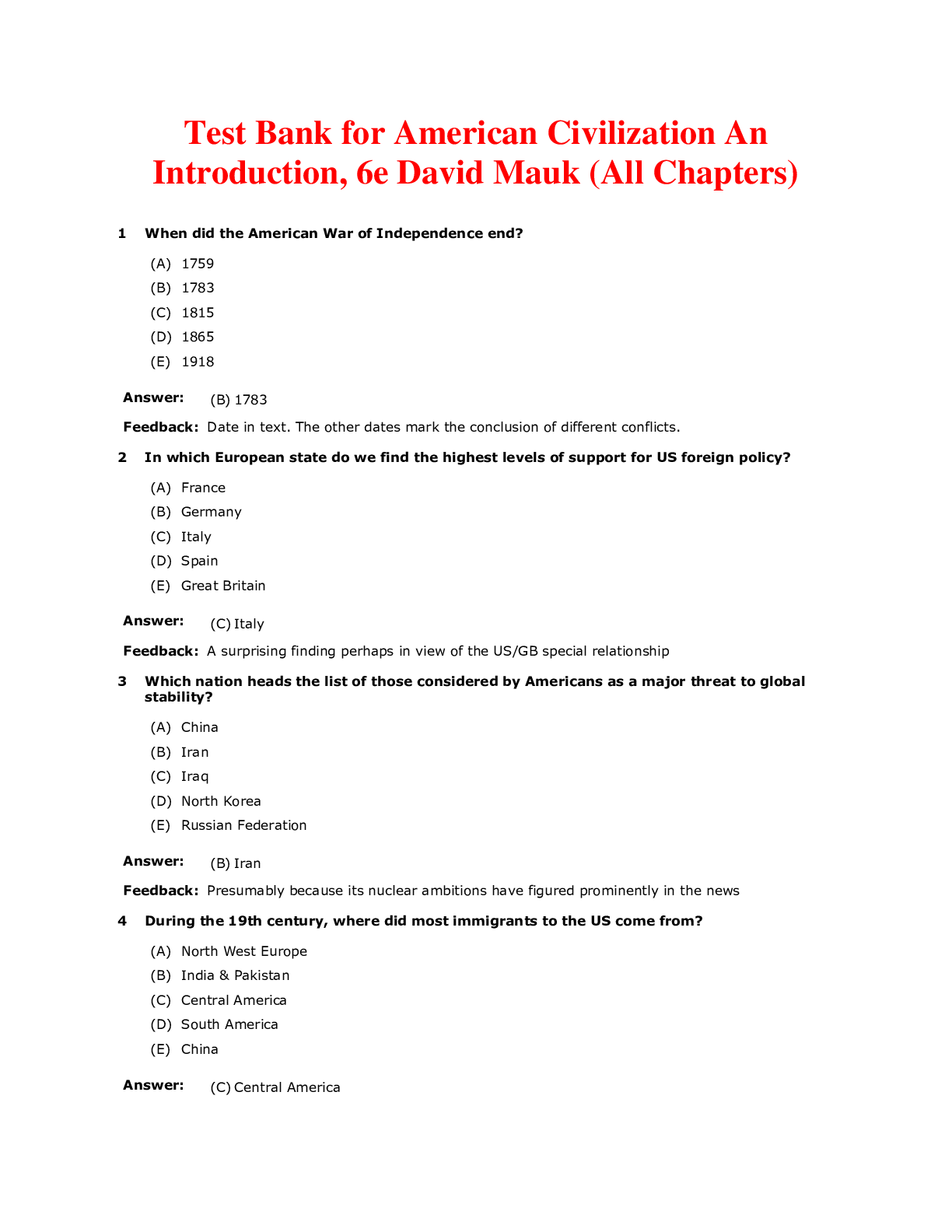
, 10e David Shi, George Brown Tindall.png)
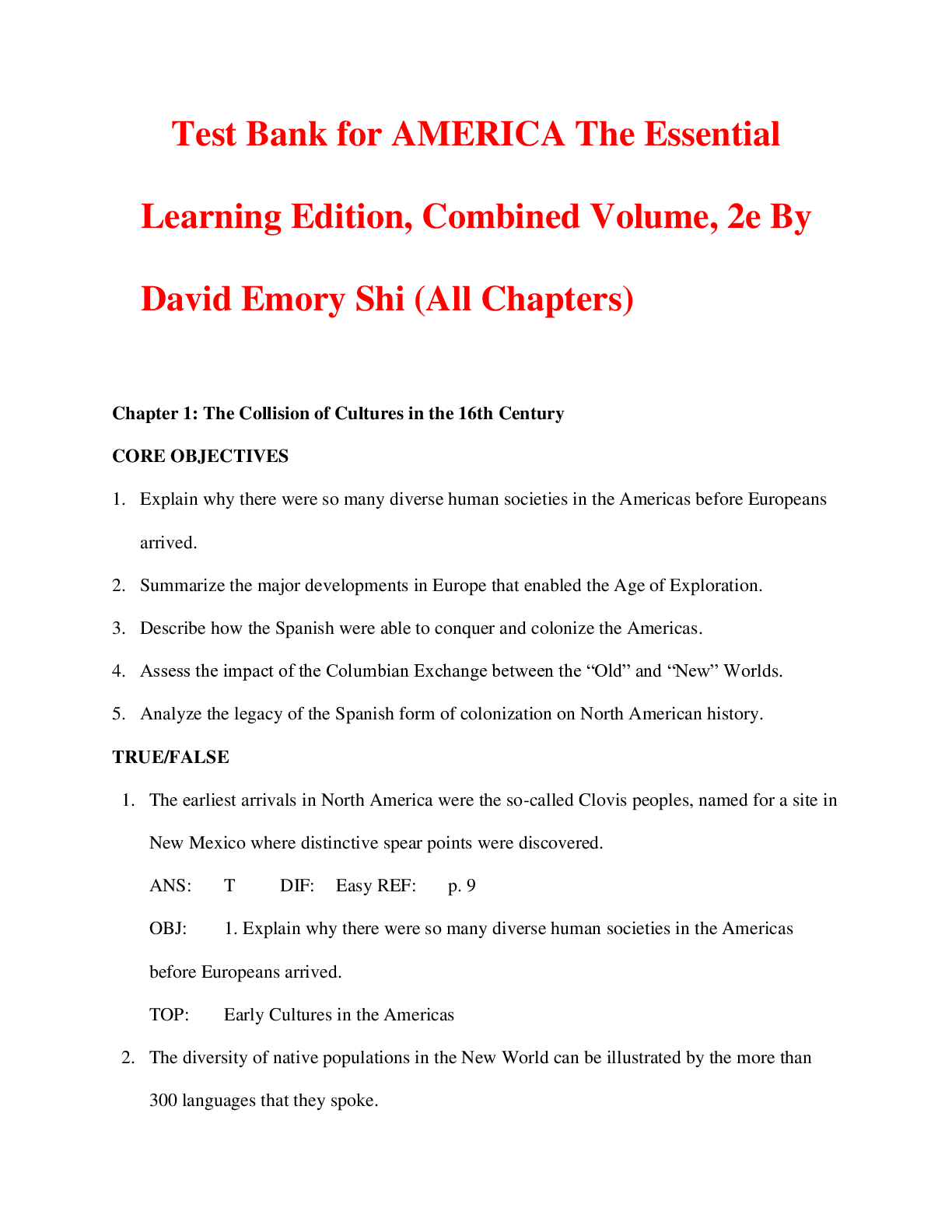
.png)

